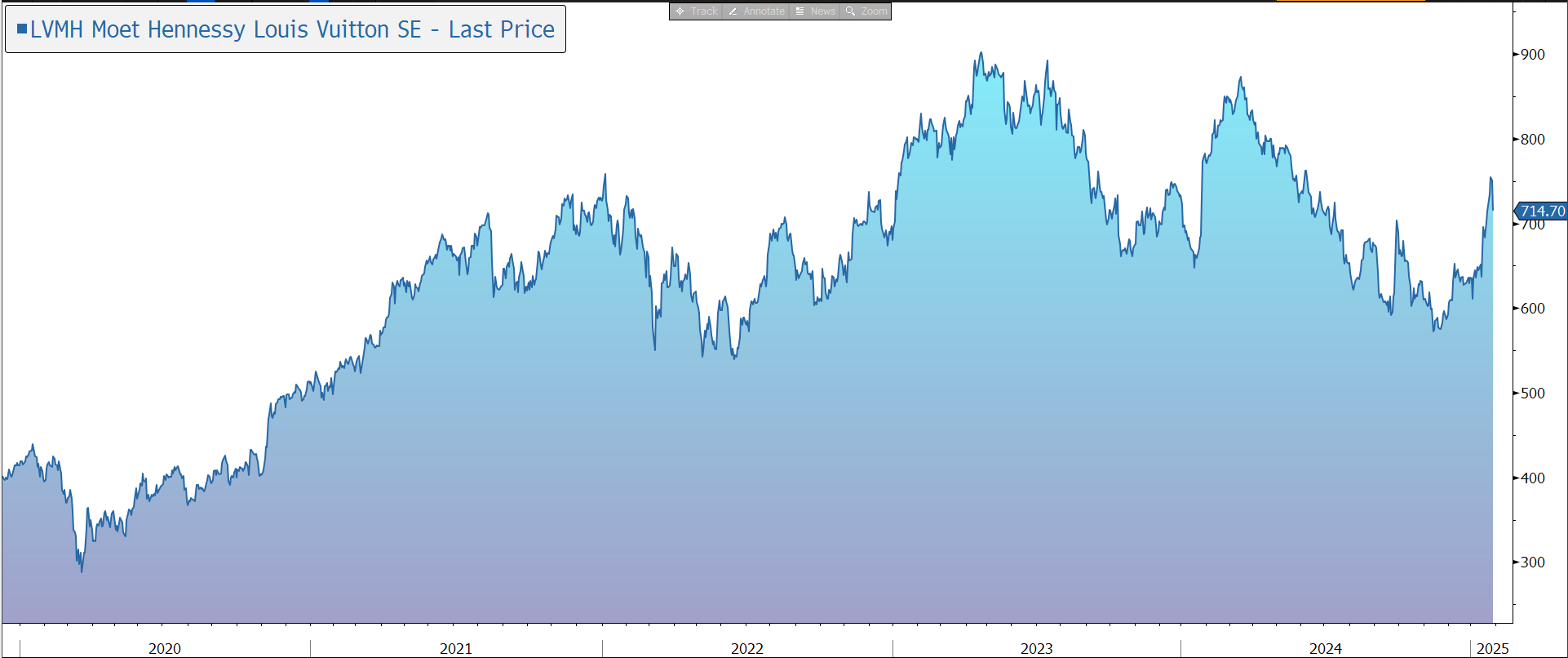Morning Note: Market news and updates from Atlas Copco and LVMH.
Market News
US equities recovered some of the previous session’s losses – S&P 500 (+0.9%); Nasdaq (+2.0%) – with the bounce driven by tech stocks. Mega Cap Tech erased all of Monday’s losses, but AI specific baskets showed only modest life. Microsoft and OpenAI are investigating whether data from OpenAI was obtained in an unauthorised manner by a group linked to DeepSeek, people familiar said.
The focus turns to the Federal Reserve’s rate decision and US mega-cap earnings. Bond traders are increasing bets on Treasuries in the hope the central bank will signal a March cut is possible. The 10-year Treasury yield slipped to 4.52%, while gold trades at $2,763 an ounce. The Trump administration has announced a sweeping $3tn freeze on federal spending in a constitutional fight over spending powers.
In Asia this morning, stocks followed Wall Street’s lead: Nikkei 225 (+0.9%). Most other major markets in the region are closed for Lunar New Year holidays. The Bank of Japan board signalled intent to keep hiking rates, December meeting minutes show.
The FTSE 100 is currently little changed at 8,535. Rachel Reeves will pledge in a major speech today to go “further and faster” to boost the UK economy by unblocking new infrastructure projects. 10-year Gilts yield 4.62%, while Sterling trades at $1.2440 and €1.1930.
The ECB is expected to cut interest rates tmrw aggressively due to US tariffs and political turmoil in the region. Traders are positioning for the euro to weaken, potentially to below $1, and for bonds to gain in the coming months. ECB is expected to make deeper cuts to shore up growth.
Source: Bloomberg
Company News
Yesterday Atlas Copco released Q4 results which were better than the market forecast. The group generated organic order growth, record revenue and record cash flow, and raised its dividend by 7%. Looking forward, the group expects that customer activity will remain at the current level. In response, the shares, which are listed in Sweden, were down 3%.
Atlas Copco is a world-leading manufacturer of innovative compressors, vacuum solutions, generators, pumps, power tools, and assembly systems. The group has a diverse customer base made up of general manufacturing (22%); process industry (20%); electronics/semis (16%); construction (12%); auto (10%); and other (20%). The products help the customer to increase operational performance, save energy costs, reduce contamination, cut down on failures in the field, lower noise levels, and extend service intervals.
As a result, the company provides exposure to a broad range of trends: demand for increased energy efficiency and reduced emissions; increased use of lightweight materials in transport industries; the transition from petrol to electric vehicles; increased use of demanding materials and production environments in processes for semiconductor and industrial production; increased production automation and smart factories; demand for improved ergonomics; and increased demand for digitally-supported service offers. Overall, the company will play a role in the effort to reorganise and improve the resilience of supply chains, bring manufacturing closer to domestic markets, and increase automation in the face of higher labour costs or deteriorating demographics. Finally, over time the vacuum business should benefit from the expansion of the North American semiconductor manufacturing market.
The target is to grow revenue by 8% per annum, primarily through organic means, complemented by selective acquisitions of companies in or close to existing core competencies. The group operates an asset-light strategy – only components that are critical to the performance of the equipment are manufactured in-house. The company has integrated itself with its customers and can provide rapid and extensive services and support of their installed base of equipment. 36% of revenue (and 50%+ of operating profit) is generated from service (i.e., spare parts, maintenance, repairs, consumables, accessories, and rental). This is more stable than equipment sales (64%) and provides a strong base for the business and greater resilience in difficult times. The cost of the group’s equipment is low relative to the customer’s operating costs and, as a result, the company has strong pricing power, important at a time of raw material cost inflation. Atlas Copco is based in Sweden and reports in Swedish Krona (SEK).
During the final quarter of 2024, the overall demand for the group’s equipment and services increased somewhat compared to the previous year but as expected weakened somewhat compared to the third quarter.
Revenue grew by 2% to a SEK 46.0bn, versus the market forecast of SEK 45.0bn. In organic terms, which excludes M&A (+2%) and currency (zero), revenue was flat. In the full year, growth was 2% to a record SEK 176.8bn, of which 2% was also organic.
Order intake grew by 4% in organic terms in Q4 to SEK 39.7bn, slightly better than the market forecast of SEK 38.7bn. For the full year, orders were flat at SEK 171bn.
Atlas Copco operates through four divisions or ‘Techniques’, with the performance in the final quarter as follows:
• Compressor Technique (44% of 2024 sales): organic revenue and orders rose by 2% and 3%.
• Vacuum Technique (23% of sales): organic revenue fell by 10%, while orders rose by 2%.
• Industrial Technique (17% of sales): organic revenue rose by 2%, while orders fell by 5%.
• Power Technique (16% of sales): organic revenue and orders were up 5% and 16%.
Year-on-year, the order intake for industrial compressors remained basically unchanged, while order volumes for gas and process compressors increased notably. Orders for vacuum equipment to the semiconductor industry remained largely at the same levels as the previous year, while the demand for industrial vacuum equipment continued to soften. The order intake for industrial assembly and vision solutions decreased due to weaker demand from the automotive and general industry. Solid order growth was recorded for power equipment due to increased demand for portable compressors, generators, and industrial pumps. The service business continued to grow with increased order intake in all business areas.
Atlas Copco generates attractive margins, with gross above 40%, providing some shelter against rising raw material costs, and operating margin above 20%. In Q4, adjusted operating profit rose by 0.7% to SEK 10.0bn, beating the SEK 9.6bn market forecast, with the margin down 30 basis points to 21.8%, driven by lower volume, sales mix, and dilution from recent acquisitions. In the full year, adjusted operating profit grew by 1% to SEK 38.7bn, with the margin down by 20 basis points to 21.9%. There has been a pick-up in investment in new capacity (and the cost base) at a time of lower volume. On the analysts’ call, the company said that the manufacturing footprint investment is largely complete, while there is a healthy pipeline of R&D projects.
EPS grew by 15% in Q4 to SEK 1.60, well above the market forecast of SEK 1.53. Full-year EPS rose by 6% to SEK 6.10. The return on capital employed during the previous 12 months slipped from 30% to 28% but is still well above the group’s 8.0% cost of capital.
The company has a robust balance sheet and continues to generate strong cash flow (SEK 31bn in 2024). Net debt reduced from SEK 23.4bn to SEK 18.1bn, while interest-bearing liabilities have an average maturity of 4.7 years. Financial gearing is a very comfortable 0.4x net debt to EBITDA. The group continued to consolidate its industry with acquisitions, with 33 deals completed in 2024. The dividend policy is to pay out 50% of net income. For 2024, the group approved a payout of SEK 3.00 per share, 7% higher than the previous year, equivalent to a 1.6% yield.
During the year, Vagner Rego, formerly the Business Area President for Compressor Technique, took up the role of CEO. The Wallenberg Family (through its holding company, Investor) is the largest shareholder of Atlas Copco, having overseen its entire history, and has a member on the Board. The business is run for the long term in a way that ensures it is passed on to the next generation in a better shape than it was inherited, with a focus on consistent operational culture, financial prudence, and sensible capital allocation.
The group provided brief commentary on the near term outlook – it expects ‘customer activity will remain at the current level’.
Source: Bloomberg
Last night, luxury goods bellwether LVMH released its 2024 results, which highlighted a slowdown in growth in a challenging economic and geopolitical environment, as well as a high basis of comparison following several years of exceptional post-Covid growth. In response, the shares have been marked down by 6%.
LVHM is the world’s leading luxury products group, which owns around 75 prestigious brands and a global retail network of over 5,500 stores. In Fashion & Leather goods (48% of revenue), iconic brands include Loewe, Louis Vuitton, and Christian Dior. In Perfumes & Cosmetics (10%), the group owns Givenchy and Guerlain, while in Watches & Jewellery (12%), brands include Tag Heuer, Bulgari, and Tiffany & Co. In Wine & Spirits (7%), the group owns Moët & Chandon, Krug, Veuve Clicquot, Hennessy, Château Cheval Blanc, and Château d’Yquem. In Selective Retailing (22%), the group operates in two spheres: retail designed for the international traveller and selective retailing concepts such as Sephora and Le Bon Marche.
The company is a family-run group that seeks to build on the heritage of its ‘Houses’. A vertically integrated operating model controls every link in the value chain, from sourcing and production facilities to selective retailing. In 2024, the company generated revenue more than €84bn. Gross margins are high, in the mid-60s, while the operating margin is in the mid-20s.
In 2024, revenue fell by 2% to €84.7bn but rose by 1% on an organic basis. In the final quarter, organic growth was 1%, an acceleration versus the 3% decline in the third quarter. The company experienced a substantial negative impact on profit arising from exchange rate fluctuations, particularly on Fashion & Leather Goods and Wines & Spirits.
By geography, Europe (+3%) and the US (+2%) posted growth on a constant consolidation scope and currency basis; Japan saw double-digit revenue growth (+28%); the rest of Asia fell by 11%.
By division, Fashion & Leather Goods suffered an organic revenue decline of 1%, with Louis Vuitton was once again driven by its capacity for innovation in the world of travel. Perfumes & Cosmetics grew by 4%, driven in particular by the success of Dior’s Sauvage, which remained the world’s best-selling fragrance. Wine & Spirits recorded an 8% decline in organic terms reflecting the ongoing normalisation of demand that began in 2023. Watches & Jewellery fell by 2%, while Selective Retailing was up 6% driven by Sephora which consolidated its position as world leader in beauty retail
Profit from recurring operations fell by 14% to €19.6bn, equating to an operating margin of 23.1%. Although this was down from 26.5% the previous year, it remains above pre-Covid levels.
Operating investments of €5.5bn were made in 2024, mainly dedicated to the expansion of the store network and the development of production facilities, including €1.7bn in France. Free cash flow rose by 29% to €10.5bn, leaving the company with net financial debt 14% lower at €9.3bn. At the Shareholders’ Meeting in April, LVMH will propose a dividend of €13 per share, in line was last year.
The group hasn’t provided specific guidance but highlights that in uncertain geopolitical and macroeconomic backdrop, management is confident and will pursue its brand development-focused strategy, underpinned by continued innovation and investment. The objective once again is to reinforce its global leadership position in luxury goods in 2025.
Source: Bloomberg



